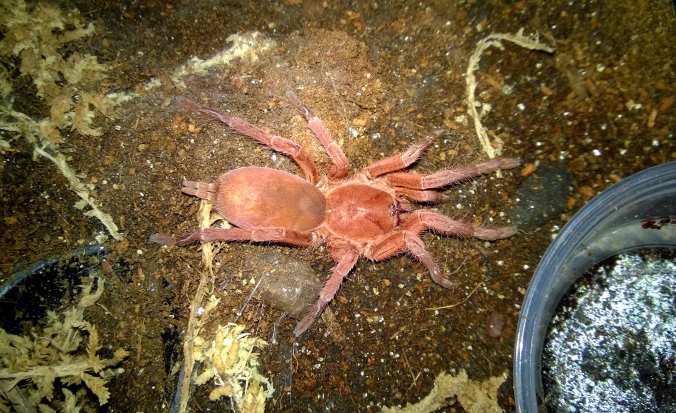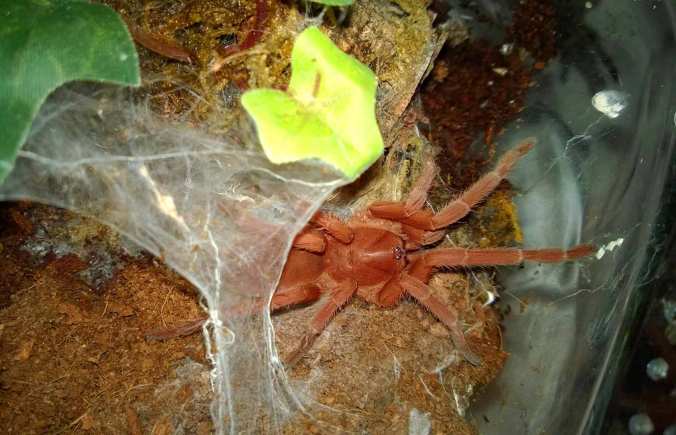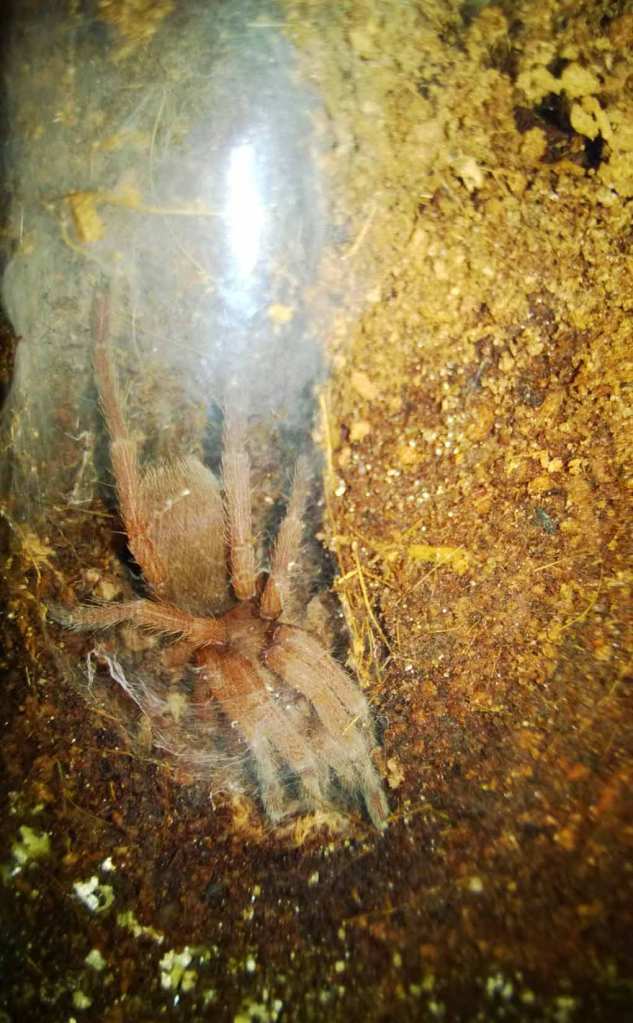A sleek, secretive Tarantula, and a unique-looking species, the Oprhanaecus philippinus, or Philippine Tangerine, is a species that should enjoy more popularity in the pet trade. From the Philippines, this old world tarantula and obligate burrower thrives in warmer and more humid conditions. Unlike many terrestrial species, O. philippinus have lithe frames with long, slender legs, a pill-shaped abdomen and an overall sleeker build. At a max length of around 6″, this is an impressive animal. A gorgeous orange/tangerine color overall, these Ts have shorter hair, which gives them a very soft, velvety appearance.
Despite being an old word species, my O. philippinus slings would much rather flee to their burrows than stand and fight. They are obligate burrowers, and they require deep substrate so that they can construct suitable dens. This is a species that requires a more humid climate, and for them to thrive, they do need slightly moist substrate. When presented with two starter dens, one on the dry side of the enclosure and one on the moister side, both of mine chose the moist side to create their homes.
For substrate, I keep them on a mixture of coco fiber and peat moss with a bit of vermiculite mixed in on the bottom to help maintain moisture. I will then sprinkle water in occasionally to keep the surface just a bit moist. The majority of the water will percolate down the sides of the enclosure keeping the lower levels more damp than the upper levels. This allows my T to burrow and chose the level of moisture it needs. I also allows for water to evaporate more slowly, keeping the humidity up.
Once its den is constructed, the O. philippinus will wait just inside the entrance hole for a prey item to stumble by. When the unfortunate insect is sensed, the O. philippinus will launch out of its hole, ambushing the insect and grabbing its meal. It will then drag the item back into its den so that it can eat in private. In my experience, they are voracious eaters who will only refuse a meal when in premolt. When mine were about 2″, they had no problem taking down larger crickets. I feed them appropriately-sized cricket or roach every three days or so.
As far as a downside for these wonderful creatures, there are few. Humidity and moisture requirements can make the husbandry a little trickier. Moisten substrate too much, and you run the risk of creating hospitable conditions for mold and mites. Keep it too dry, and your O. philippinus is likely to dehydrate. Moist substrate AND proper ventilation is key. They are also VERY fast, and can go from crouching in a corner to out of the enclosure in a blink of an eye. Keepers not used to keeping faster species could find this shocking.
For temperatures, they are kept at mid to low 70s although they will thrive at temps in the low 80s as well. As with most species, higher temps will bring faster metabolisms and growth rates. I’ve kept mine for about a year, and in that time they have gone from 1.25″ slings to 3.5″ sub-adults. I have not noticed a significant difference in growth rate between the winter months where they are kept mid to low 70s and the summer when temps are high 70s to low 80s.

O. philippinus Pulling a Cricket into It’s Den
http://www.youtube.com/watch?v=nLGd8t02hsk Because they spend the majority of the time in burrows and normally venture out only at night, sightings of your prized pet may be rare. Personally, I enjoy the thrill I get when I catch one of my slings out and about; or when I witness one snag a prey item. They are an amazing , beautiful, and unique tarantula that would make an excellent addition to any collection.


Tips for rehoming one of these and how to tell when it’s done with premolt as I rarely see mine, last time I did it was in premolt and ready to up size an enclosure when molted, haven’t seen it since and it’s rejecting all food.
LikeLike
I’ve found that mine will web over the mouth of their burrow when they are in premolt and open it back up again when they are done. Sometimes, it’s only a thin coating of web, so it can be overlooked. I’ve also noticed that when they are ready to eat, you’ll see them hanging out close to the top of their burrows; I can usually see the front legs.
I actually JUST shot a rehousing video on mine on Saturday. I cheated a bit, though, as mine was hanging outside of its burrow. When I have to dig them out, I do it like in the video below (easier to see it than to explain).
I just take my time, use a long spoon, and am careful not to hit the T. Most will cower in a corner as you dig, so the idea is to cup them before they can freak out an bolt.
How large is yours?
Tom
LikeLike
Tom, I just picked up my first O Philippinus along with my first true Blondi sling. I am absolutely in love with the both of them, great eaters, very pretty. I am going to be breeding mine once they are large enough, and in the meantime i have a few projects with some other species. The way that the tangerine looks is so cool plus the heavy webbing sold me. You should definitely do another vid of your girl soon!
LikeLiked by 1 person
Hi, Brandon! I love both of those species…congrats! I can definitely do another vid really soon!
LikeLike
You never said what the humidity levels should be ..
LikeLike
Hi, Micah. That’s because you really shouldn’t worry about precise humidity levels. The whole “ideal humidity level” thing is a myth and does more harm than good. I’ve kept tarantulas for years, and I NEVER measure the humidity levels inside the enclosures. What you have is “moisture dependent species.” These tarantulas require moist substrate (the bottom levels should stay moist while the top can dry out a bit). Here’s an article about humidity levels: https://tomsbigspiders.com/2015/01/19/humidity-temperature-and-tarantulas/
Here’s my latest video on this species: https://www.youtube.com/watch?v=CK669KDXJAM&t=21s
Let me know if you have any other questions.
LikeLike